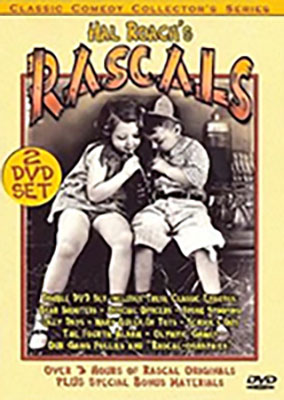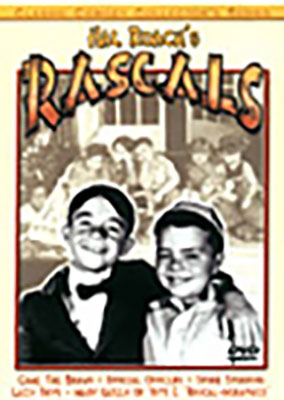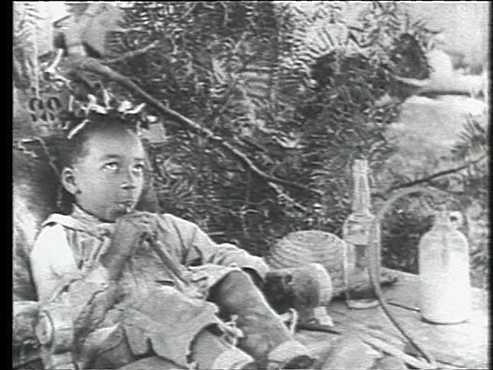
Reviews of silent film releases on home video.
Copyright © 1999-2024 by Carl Bennett
and the Silent Era Company.
All Rights Reserved. |
|
Hal Roach’s
Rascals
(1925-1938)
|
Contents: Mary, Queen of Tots (1925), Official Officers (1925), The Fourth Alarm! (1926), Olympic Games (1927), Spook-Spoofing (1928), Lazy Days (1929), Hi, Neighbor! (1934), Spooky Hooky (1936) and Came the Brawn (1938).
In 1922, Hal Roach created a new series of comedy short films starring a group of young kids who, although they were officially named Hal Roach’s Rascals, quickly became popularly known by the title of one of their earliest films, Our Gang (1922). Roach soon learned that he had tapped a gold mine, and produced far more than 100 Our Gang films from 1922 through 1938, when the rights to the series were sold to Our Gang distributor Metro-Goldwyn-Mayer. The series featured a number of talented and popular child performers who inevitably grew too old to remain participants in the series and were replaced by other children. Fans of the Our Gang series grew to love Mickey, Jackie, Joe, Farina, Mary, Wheezer and others, and later grew attached to Spanky, Alfalfa, Porky, Buckwheat, Darla and Butch in the golden era.
In Official Officers (1925) the gang sets up a game of stickball in the trash-strewn city streets, as a result they are holding up street traffic. A cranky cop chases the gang out of the streets and arrests them. A supervisor replaces the cop with another, friendlier cop, and the new cop appoints the gang junior officers for the neighborhood. The gang dresses up in uniforms and drives a paddy wagon of their own making, then take to the streets to maintain law and order. Under the new policeman’s and the gang’s regime, the streets are cleaned up and peace resides. That is until the cranky cop comes back to the neighborhood, now fired from the force, only to be arrested by the gang. To escape the man clubs the friendly officer and the chase is on. The gang tracks him down and subdues him for arrest once again.
Mary, Queen of Tots (1925) is a fantasy story of the rich but lonely Mary, stuck in her room by a strict governess, playing with four dolls bought for her by the kindly gardener. The dolls become living players (Joe, Mickey, Farina and Jackie) in Mary’s sleepy fantasy, creating havoc as they explore her room. But the governess discovers the dolls, tosses them into a garbage can outside and leaves to run errands. Mary awakes to discover the dolls are gone and goes looking for them, discovering the real gang boys playing outside. Convinced the boys are her dolls come to life, Mary brings the boys into her large house to play. Boys will be boys, and they commence to tear the place up, playing as they normally would. The situation develops to allow Mary to get back at her mean governess. The film is notable for featuring a number of well-done special effects shots.
The Fourth Alarm! (1926), in which Joe has to feed his baby sister her medicine every fifteen minutes. The local fire chief has adopted the neighborhood kids and does what he can to take care of them. When a fire catches in the kitchen of a neighborhood home, the gang sees this and jumps into action, grabbing an extinguisher and putting out the fire before the firemen arrive. Impressed by their quick thinking and resourcefulness, the chief makes the gang honorary firemen. Not only do the young firegang do their best to excute their duty, Joe still manages to give his sister her medicine. When a big fire breaks out near a cache of explosives, the gang pitches in to help put out the fire. Even Pal, the dog, pitches-in in the end.
In Olympic Games (1927) the gang hones their athletic skills for competition, until Wheezer and his razzberry-blowing dog, Minnie, disrupt the practice. A number of unfortunate neighborhood kids, even Farina, catches the blame. The games start and several of the gang encounter a number of problems, which devolves into an egg and vegetable-throwing fight with neighborhood boys.
Spook-Spoofing (1928) is a surprisingly cruel film in which the gang (especially Joe) takes advantage of the superstitious and gullible Farina. After a series of pranks, Farina lets the Joe know that he has a protective ‘Mumbo-Jumbo’ charm that he’ll use if the pranks don’t stop. When the undertaker’s son measures Farina for a coffin, Farina’s superstitions about ghosts and death come out. Joe sees an opportunity and gets one of the gang to pick a fight with Farina, instructing him to play dead if rubbed by Farina’s charm. Well, the charm does get used and the boy does play dead, but gullible Farina doesn’t know this. The gang covers the ‘dead’ boy with a sheet and puts him in a wagon, and instruct Farina to bury the boy in the graveyard or be haunted forever. On top of that the gang plants the story of the graveyard witch into Farina’s head. Eventually, however, the pranksters get their just deserts in a funny denouement. Knowing the plot makes the title of the film inexcusable today, but it is another example of the pervasive and commonly-accepted attitudes and character cliches African-Americans endured in the silent era. Yet, despite that, we get a good chance to see Allan Hoskins’ skill as a comic actor and why Farina was one of the best-loved characters in Our Gang history.
These retrospective collections show that Farina endured more pain and humiliation than any other member of Our Gang, between nearly being run over, squirts of water in the face, bothering bees, smashed feet, puffs of powder, boots in the bottom, doorknobs in the forehead, etc. Also of note is that the silent era films were largely shot outdoors, even when sound film production began, while the later Our Gang films of the mid to late 1930s where mainly shot indoors on soundstages.
— Carl Bennett
|
 Brentwood Home Video Brentwood Home Video
2000 DVD edition
Hal Roach’s Rascals (1925-1938), black & white, 185 minutes total, not rated, including Mary, Queen of Tots (1925), black & white, 20 minutes, not rated, Official Officers (1925), black & white, 21 minutes, not rated, The Fourth Alarm! (1926), black & white, 18 minutes, not rated, Olympic Games (1927), black & white, 17 minutes, not rated, Spook-Spoofing (1928), black & white, 22 minutes, not rated, Lazy Days (1929), black & white, 20 minutes, not rated, Hi, Neighbor! (1934), black & white, 17 minutes, not rated, Spooky Hooky (1936), black & white, 10 minutes, not rated, and Came the Brawn (1938), black & white, 11 minutes, not rated.
Brentwood Home Video, 69892-9, UPC 0-90096-98929-7.
Two single-sided, single-layered, Region 0 NTSC DVD discs, 1.33:1 aspect ratio image in full-frame 4:3 (720 x 480 pixels) interlaced scan MPEG-2 format, SDR (standard dynamic range), 5.5 Mbps average video bit rate, 192 Kbps audio bit rate, Dolby Digital 48 kHz 2.0 mono sound, English language intertitles; chapter stops; two standard DVD keepcases in cardboard slipcase; $14.98.
Release date: 17 October 2000.
Country of origin: USA
Ratings (1-10): video: 4 / audio: 5 / additional content: 2 / overall: 5.
|
 This budget two-disc DVD collection of nine Our Gang films, six from the silent era (including one silent era early sound film), provides DVD collectors with the opportunity to purchase a representative sampling from the history of the Rascals films. The package is presented in two keep cases with a light cardboard slipcase. As is typical of budget discs, the presentations of the films are not the best available but most of them are quite watchable.
This budget two-disc DVD collection of nine Our Gang films, six from the silent era (including one silent era early sound film), provides DVD collectors with the opportunity to purchase a representative sampling from the history of the Rascals films. The package is presented in two keep cases with a light cardboard slipcase. As is typical of budget discs, the presentations of the films are not the best available but most of them are quite watchable.
Disc one includes Official Officers (1925), which has been transferred from a Kodak Cinegraph reduction print. The transfer has problems right off the bat, with several brief sections of the film repeated one after another. (We’ve encountered this type of glitch before and think that the computer system used to master the disc hiccuped several times while reading the video data from its hard disk drive.) The print itself is contrasty with highlight image details blasted out to white. The picture is slightly soft in image details as well, indicating an older 16mm print. Overall, the intertitles are readable and the action easily followed, but we are certain that better prints of this film exist. The video transfer has been done at sound speed so the action is faster than it should be. The music is a canned soundtrack that should be familiar to regular viewers of public-domain videotapes. Overall, this is the toughest viewing on the disc due to the often repeated sections. This problem should have been corrected before the disc was released.
The video transfer for Mary, Queen of Tots (1925) has been prepared from a good but contrasty 16mm reduction print that is missing the original main title but maintains the original intertitles. The contrasy and blurry picture is watchable but is another example of why we dislike old 16mm reduction prints of silent era films. The transfer contains a few distracting videotape master glitches, and the musical accompaniment is stock orchestral music.
Spook-Spoofing (1928) has been prepared from a very-good Blackhawk Films 35mm preservation print. As is typical of the Blackhawk prints, the main titles and all of the intertitles have been replaced by new titles. The original footage itself features a broad greyscale range and very good image detail, with light speckling and dust, and a small amount of light to moderate scuffing and other print damage. The musical accompaniment is a Wurlitzer pipe organ performance by Gaylord Carter recorded for the Blackhawk print.

Lazy Days (1929) has been prepared from a very good Blackhawk Films 35mm preservation print, with the original Movietone soundtrack. The videotape master has a number minor and major playback glitches in it.
Came the Brawn (1938) The latest film in the collection and one of the last Our Gang films produced by Hal Roach. The gang is staging a wrestling match with ‘Wild-Cat’ Alfalfa matching up with the ‘Masked Marvel.’ Alfalfa wants to wrestle a neighborhood kid who is the least likely to offer any resistance. He chooses bookworm Waldo, but he winds up with bully Butch. The video transfer has been prepared from a good 16mm reduction print, with the original main titles replaced but with the MGM lion-growl intro intact. The print is slightly contrasty with some highlight image details blasted out to white. The print is tightly cropped with the tops of some heads disappearing into the top of the frame.
 Disc two includes The Fourth Alarm! (1926), which has been prepared from an okay 16mm reduction print, with the main title and the intertitles intact. The print is quite contrasty, with washed-out whites and plugged-up shadows and a moderate amount of greyscale detail in between. Much of the time, the film is too contrasty to see facial expressions on the kids. The cropping of the transfer cuts off the intertitles and picture on the right side while the left side clearly reveals the left edge of the print’s frameline. The print has been transferred at sound speed, which means the action is presented too fast, and the film is accompanied by a cobble-together soundtrack of vintage 78 RPM jazz recordings. Easily, this is the worst presentation in the collection. Disc two includes The Fourth Alarm! (1926), which has been prepared from an okay 16mm reduction print, with the main title and the intertitles intact. The print is quite contrasty, with washed-out whites and plugged-up shadows and a moderate amount of greyscale detail in between. Much of the time, the film is too contrasty to see facial expressions on the kids. The cropping of the transfer cuts off the intertitles and picture on the right side while the left side clearly reveals the left edge of the print’s frameline. The print has been transferred at sound speed, which means the action is presented too fast, and the film is accompanied by a cobble-together soundtrack of vintage 78 RPM jazz recordings. Easily, this is the worst presentation in the collection.
The transfer for Olympic Games (1927) has been prepared from a good 16mm reduction print, with the original main title and intertitles intact. Like most of the older 16mm prints, the print is contrasty with blasted-out highlights. The film is accompanied by a soundtrack of vintage jazz recordings.
Hi, Neighbor! (1934) features a very young Spanky who sees a beautiful toy fire engine on a moving van. The boys follow the van to a house where a family with a very snooty boy are moving in. Hoping to be able to play with the fire engine the boy try to make friends with the new kid who, instead, snubs the gang. Not to be discouraged, the gang builds their own fire engine. The video transfer is from a very good Blackhawk Films 35mm preservation print. The print generally has a broad range of greytones and very good image detail. A number of videotape glitches also mar this presentation.
Spooky Hooky (1936) has Spanky, Alfalfa, Buckwheat and Porky planning to play hooky from school to see the circus. When they learn that the whole class will be treated to a visit to the circus, they have to retrieve a fake note to the ‘teecher’ from ‘the doctor’ left in the locked schoolhouse. When the school janitor refuses to let them in, the boys decide to come back that stormy and spooky evening. The transfer appears to be from a very good 35mm preservation print, with a broad range of greytones and very good detail. Again, a few videotape glitches are seen here.
Despite the 5.5 average video bit rate, the resolution of the video transfers are lower than usual, producing a coarse and blocky picture (as any still frame will reveal). All of the video transfers appear to be from older analog video masters, and playback to master these discs is frought with minor and major glitches.
For our notes on the individual silent era films, see our Lazy Days on home video page.
The discs are supplemented with a brief history of the Our Gang series and “Rascal-ographies” of six of the best-known male Our Gang members. They also include a worthless ‘Hollywood Hall of Fame’ documentary on Hal Roach’s Rascals, with footage mostly culled from the films in the two-volume collection.
Overall, we like this collection that favors the silent era films from the Our Gang series, but we abhor the poor prints that were utilized for the transfers and the negligent video mastering of the discs. The collection is worth its low cost, but be prepared to toss the discs if higher-quality presentations of the films are ever released.
|
|
USA: Click the logomark to purchase this Region 0 NTSC DVD edition from Amazon.com. Your purchase supports Silent Era.
|

|
|
|
Canada: Click the logomark to purchase this Region 0 NTSC DVD edition from Amazon.ca. Your purchase supports Silent Era.
|

|
|




































